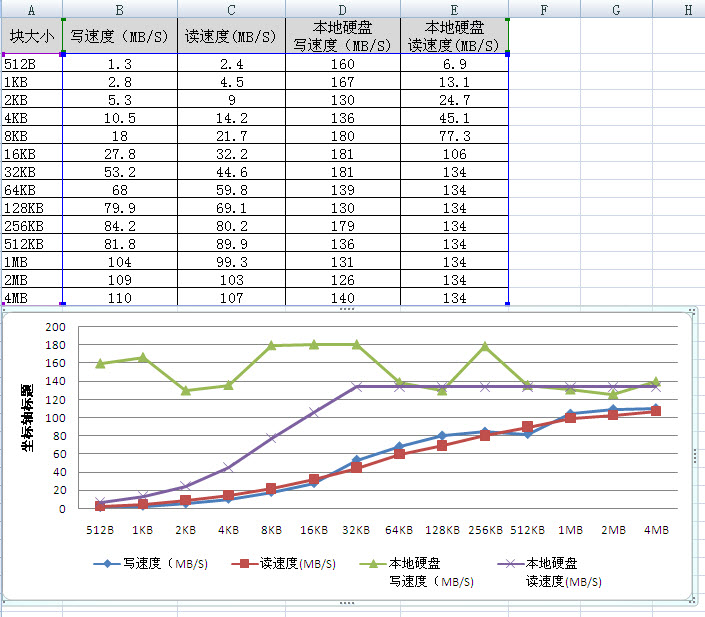您好,登錄后才能下訂單哦!
您好,登錄后才能下訂單哦!
小編給大家分享一下Linux下磁盤io測試怎么用,相信大部分人都還不怎么了解,因此分享這篇文章給大家參考一下,希望大家閱讀完這篇文章后大有收獲,下面讓我們一起去了解一下吧!
這兩天在測試Dell的PS6000存儲,在linux下也懶得去找測試工具了,就直接使用dd命令進行I/O測試,但因為需要測試的數據很多,從512b到4M的塊,每一檔都要進行讀寫的測試,這要是人肉來做,那就太累了,于是就產生了下面這個腳本。
本腳本使用perl編寫,根據測試用例,完成每次讀或寫測試。
本腳本共有3個參數,兩個是必選參數,一個是可選參數
-r 測試讀性能
-w 測試寫性能
-c 可選參數,用于關閉文件系統的緩存
#!/bin/evn perl
use JSON;
use Data::Dumper;
use Cwd;
use File::Basename;
our $cache_flag = '';
# 獲取腳本所在目錄
my $cwd;
if ( $0 =~ m{^/} ) {
$cwd = dirname($0);
}
else {
my $dir = getcwd();
$cwd = dirname("$dir/$0");
}
# 獲得參數
if ( @ARGV < 1 ) {
&usage;
exit;
}
elsif ( @ARGV == 1 ) {
if ( ( $ARGV[0] ne "-r" ) && ( $ARGV[0] ne "-w" ) ) {
print "Unrecognized Option\n";
&usage;
exit;
}
}
elsif ( @ARGV == 2 ) {
if ( $ARGV[0] eq "-r" ) {
$cache_flag = "iflag=direct,nonblock";
}
elsif ( $ARGV[0] eq "-w" ) {
$cache_flag = "oflag=direct,nonblock";
}
elsif ( ( $ARGV[0] ne "-r" ) || ( $ARGV[0] ne "-w" ) ) {
print "Unrecognized Option\n";
&usage;
exit;
}
}
my $opt = $ARGV[0];
# 使用幫助
sub usage {
print "Usage: iotest.pl [OPTION] [OPTION]\n";
print "\n";
print "-r\texecute read test\n";
print "-w\texecute write test\n";
print "-c\tiotest with local filesystem cache\n\n";
}
# 檢查測試文件是否存在
sub check_file {
if ( !-e "./iotest" ) {
print "The test file dose not exist,please run write test first\n";
exit;
}
}
# 打開測試用例
open FH, "<$cwd/iotest.json";
# Main #
while () {
chomp;
$json = new JSON;
# 將測試用例的json格式轉成hash
my %strings = %{ $json->decode($_) };
if ( $opt eq "-r" ) {
&check_file;
while ( ( $key, $value ) = each %strings ) {
open rfh, '>>iotestr.log';
my $cmd =
"/bin/dd if=./iotest of=/dev/null bs=$key count=$value $cache_flag >> iotestr.log 2>&1";
print rfh "IOTest Block: $key\n";
`$cmd`;
print rfh "\n";
}
}
elsif ( $opt eq "-w" ) {
while ( ( $key, $value ) = each %strings ) {
open wfh, '>>iotestw.log';
my $cmd =
"/bin/dd if=/dev/zero of=./iotest bs=$key count=$value $cache_flag >> iotestw.log 2>&1";
print wfh "IOTest Block: $key\n";
`$cmd`;
print wfh "\n";
}
}
}下面來看下測試用例的編寫格式。這里蚊子采用了json串的方式,這樣便于perl讀取,文件內容如下
{"512":"4096000","1K":"2048000","2K":"1024000","4K":"512000","8K":"256000","16K":"128000","32K":"64000","64k":"32000","128k":"16000","256k":"8000","512k":"4000","1M":"2000","2M":"1000","4M":"500"}該文件主要就分兩個字段,冒號前的是塊大小,冒號后的count數,通過塊大小和count數就能創建文件,蚊子這里統一生成的是2G大小的文件。該文件保存文件名為iotest.json,將測試用例和測試腳本放到同一個目錄下即可。使用方面很簡單,進入到要測試的磁盤或目錄下,執行
#perl /dir/to/iotest.pl –w
即可完成開啟文件系統換的磁盤寫測試。程序執行完畢后會在當前目錄下創建.log文件用于記錄測試結果,下圖是蚊子測試的結果,我做成了表格。

以上是“Linux下磁盤io測試怎么用”這篇文章的所有內容,感謝各位的閱讀!相信大家都有了一定的了解,希望分享的內容對大家有所幫助,如果還想學習更多知識,歡迎關注億速云行業資訊頻道!
免責聲明:本站發布的內容(圖片、視頻和文字)以原創、轉載和分享為主,文章觀點不代表本網站立場,如果涉及侵權請聯系站長郵箱:is@yisu.com進行舉報,并提供相關證據,一經查實,將立刻刪除涉嫌侵權內容。